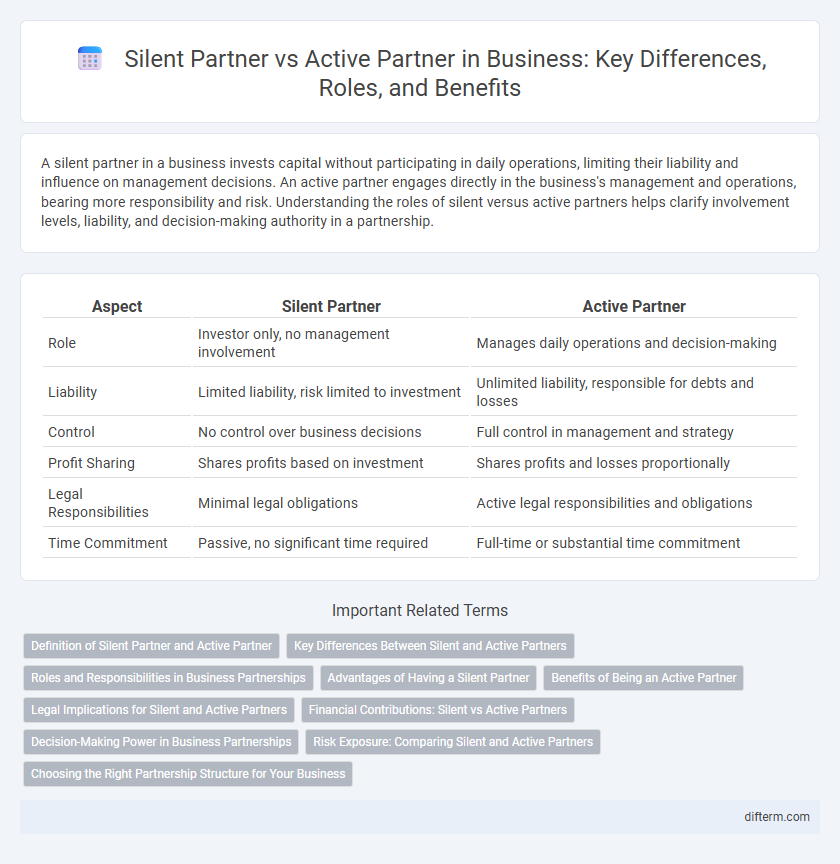A silent partner in a business invests capital without participating in daily operations, limiting their liability and influence on management decisions. An active partner engages directly in the business's management and operations, bearing more responsibility and risk. Understanding the roles of silent versus active partners helps clarify involvement levels, liability, and decision-making authority in a partnership.
Table of Comparison
| Aspect | Silent Partner | Active Partner |
|---|---|---|
| Role | Investor only, no management involvement | Manages daily operations and decision-making |
| Liability | Limited liability, risk limited to investment | Unlimited liability, responsible for debts and losses |
| Control | No control over business decisions | Full control in management and strategy |
| Profit Sharing | Shares profits based on investment | Shares profits and losses proportionally |
| Legal Responsibilities | Minimal legal obligations | Active legal responsibilities and obligations |
| Time Commitment | Passive, no significant time required | Full-time or substantial time commitment |
Definition of Silent Partner and Active Partner
A silent partner in a business is an investor who contributes capital but does not participate in daily management or decision-making processes, limiting their liability to their investment. In contrast, an active partner takes an active role in managing operations, making business decisions, and typically shares both profits and liabilities. Understanding the distinction between silent partners and active partners is crucial for defining roles, responsibilities, and legal obligations within a partnership.
Key Differences Between Silent and Active Partners
Silent partners invest capital in a business but do not participate in daily operations or management decisions, offering limited liability and reduced personal risk. Active partners engage directly in managing the business, making strategic decisions, and bear unlimited liability, enhancing operational control and responsibility. Understanding these distinctions is crucial for defining roles, risk exposure, and legal obligations within partnership agreements.
Roles and Responsibilities in Business Partnerships
Silent partners primarily invest capital without participating in daily operations or decision-making, limiting their liability to the extent of their investment. Active partners engage directly in managing the business, making strategic decisions, and are personally liable for business obligations. Clear agreements outlining each partner's roles and responsibilities are essential to prevent conflicts and ensure smooth business operations.
Advantages of Having a Silent Partner
Having a silent partner provides access to capital and financial resources without increasing management responsibilities, allowing active partners to focus on daily operations and strategic growth. Silent partners contribute expertise and credibility, enhancing business reputation while maintaining a low profile in decision-making processes. Their involvement reduces personal risk for active partners by sharing financial liabilities without direct operational involvement.
Benefits of Being an Active Partner
Active partners benefit from direct involvement in decision-making processes, allowing them to influence the company's strategic direction and operations actively. They gain comprehensive insight into business performance and have the opportunity to leverage their skills and expertise to drive growth and profitability. Additionally, active partners often receive higher returns on investment due to their hands-on contribution and risk exposure.
Legal Implications for Silent and Active Partners
Silent partners typically have limited legal liability and are not involved in daily business operations, which restricts their exposure to debts and obligations of the partnership. Active partners hold full legal responsibility, managing operations and making decisions, thus bearing personal liability for business debts and legal actions. Understanding these distinctions is crucial for defining roles, risk exposure, and legal accountability in partnership agreements.
Financial Contributions: Silent vs Active Partners
Silent partners typically contribute capital to the business without participating in daily management, allowing them to maintain limited liability and receive passive income. Active partners invest both financially and through hands-on involvement in operations, bearing greater risk and sharing decision-making responsibilities. Financially, silent partners focus solely on monetary input, while active partners combine capital contributions with ongoing commitment to business growth.
Decision-Making Power in Business Partnerships
In business partnerships, an active partner holds significant decision-making power, actively participating in daily operations and strategic planning. Silent partners typically invest capital but refrain from involvement in management or operational decisions, limiting their influence on business direction. The division of decision-making authority is often outlined in the partnership agreement to ensure clarity and prevent conflicts.
Risk Exposure: Comparing Silent and Active Partners
Silent partners face limited risk exposure as their liability is typically confined to their capital investment, without involvement in daily operations. Active partners assume greater risk due to their management role, bearing personal liability for business obligations and debts. Understanding these distinctions helps businesses allocate responsibilities and assess financial risks effectively.
Choosing the Right Partnership Structure for Your Business
Choosing the right partnership structure significantly impacts business control, liability, and profit-sharing. A silent partner invests capital without involvement in daily operations or decision-making, limiting their liability to the amount invested, while an active partner participates actively in management and bears unlimited liability. Evaluating your desired level of involvement, risk tolerance, and business goals ensures the optimal balance between control and responsibility.
Silent Partner vs Active Partner Infographic

 difterm.com
difterm.com